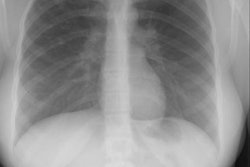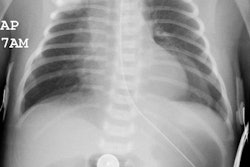AJR Am J Roentgenol 1999 Dec;173(6):1589-93
Correlation between findings on chest radiography and survival
in neonates with congenital diaphragmatic hernia.
Donnelly LF, Sakurai M, Klosterman LA, Delong DM, Strife JL
Department of Radiology, Duke University Medical Center, Durham, NC 27710, USA.
OBJECTIVE: Predictors of survival are helpful when deciding on aggressiveness of
care of neonates with congenital diaphragmatic hernia and respiratory failure.
We evaluated findings on chest radiography as potential predictors of survival
in these patients. MATERIALS AND METHODS: Findings on chest radiographs of
neonates less than 24 hr old with congenital diaphragmatic hernia were
evaluated. Radiographic findings analyzed included percentage of aerated
ipsilateral lung, percentage of aerated contralateral lung, mediastinal shift,
and hernia contents. Each finding was compared with survival (equated with
hospital discharge) using a Mantel-Haenszel chi-square test. Survival was also
determined using the total number of poor prognostic findings present in any one
patient. RESULTS: In the 73 neonates with congenital diaphragmatic hernia in our
study, the overall survival rate was 55%. There were statistically significant
relationships between survival rate and percentage of ipsilateral aeration (p =
0.001), percentage of contralateral aeration (p = 0.016), and mediastinal shift
(p = 0.026). The survival rate for multiple poor prognostic factors was 0% with
four of four factors and 20% with three of four factors (p = 0.001). Survival
rate was not influenced by prematurity (p = 0.102), sex (p = 0.104), or side of
hernia (p = 0.895). CONCLUSION: Findings on initial chest radiography are
helpful in predicting survival in neonates with congenital diaphragmatic hernia.
PMID: 10584806, UI: 20049501




